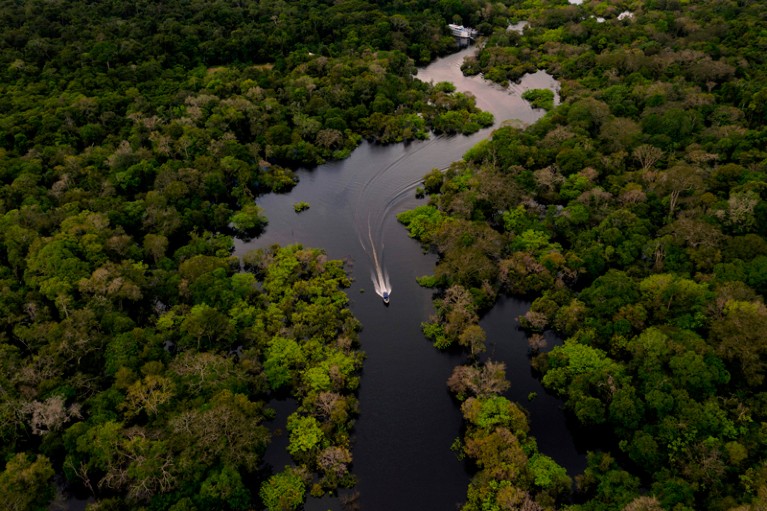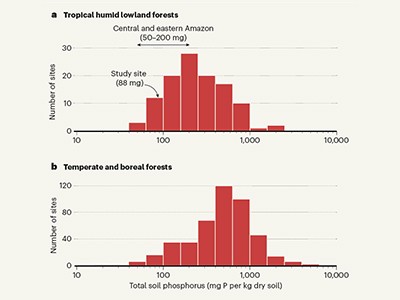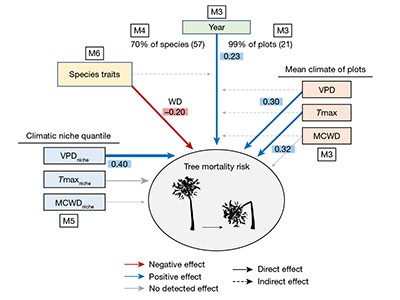
Climate models need to capture a full spectrum of data from forests such as the Brazilian Amazon.Credit: Florence Goisnard/AFP/Getty
Humanity’s understanding of how forests are responding to climate change is disconcertingly fragile. Take carbon fertilization, for example — the phenomenon by which plants absorb more carbon dioxide as its concentration in the atmosphere increases. This is one of the principal mechanisms by which nature has so far saved us from the worst of climate change, but there’s little understanding of its future trajectory. In fact, researchers don’t fully understand how climate change interacts with a multitude of forest processes. Complex, unsolved questions include how climate warming affects forest health; how it affects the performance of forests as a carbon sink; and whether it alters the ecosystem services that forests provide. Forests are our life-support system, and we should be more serious about taking their pulse.
Six papers in this week’s Nature provide important insights into those questions. They also underline some of the challenges that must be overcome if we are to fully understand forests’ potential in the fight against climate change. These challenges are not only in the science itself, but also relate to how forest scientists collaborate, how they are funded (especially where data collection is concerned) and how they are trained.
Forest science is an amalgam of disciplines. Ecologists and plant scientists measure tree growth, soil nutrients and other parameters in thousands of forest plots around the world. Physical scientists monitor factors such as forest height and above-ground forest biomass using remote-sensing data from drones or satellites. Experimental scientists investigate how forests might behave in a warming world by artificially altering factors such as temperature or carbon dioxide levels in experimental plots. Some of the data they generate are absorbed by yet another community: the modellers, who have created dynamic global vegetation models (DGVMs). These simulate how carbon and water cycles change with climate and, in turn, inform broader earth-system and climate models of the type that feed into policymaking.
Different DGVMs make different predictions about how long forests will continue to absorb anthropogenic CO2. One reason for these differences is that models are sensitive to assumptions made about the processes in forests. There are many influences — including temperature, moisture, fire and nutrients — that are generally studied in isolation. Yet they interact with each other.
Low phosphorus levels limit carbon capture by Amazonian forests
Not all DGVMs account for the dampening effect that a lack of soil phosphorus can have on carbon fertilization, for example. Much of central and eastern Amazonia is poor in phosphorus, and research has shown that introducing phosphorus limitation into DGVMs can cut the carbon-fertilization effect1. This week, Hellen Fernanda Viana Cunha at the National Institute for Amazonian Research in Manaus, Brazil, and her colleagues report2 a powerful experimental demonstration of how the soil’s poor phosphorus content limits carbon absorption in an old-growth Amazonian forest.
Models simulating the northward spread of boreal forest as temperatures rise are also missing key drivers3, according to Roman Dial at Alaska Pacific University in Anchorage and his colleagues. They report today that a white-spruce population has migrated surprisingly far north into the Arctic tundra. To explain this, it is necessary to take into account winter winds (which facilitate long-distance dispersal) along with the availability of deep snow and soil nutrients (which promote plant growth).
Models are often based on a small number of ‘functional tree types’ — for example, ‘evergreen broadleaf’ or ‘evergreen needle leaf’. These are chosen as a proxy for the behaviour of the planet’s more than 60,000 known tree species. Yet ecologists are discovering that the biology of individual species matters when it comes to a tree’s response to climate change.
Read the paper: Tropical tree mortality has increased with rising atmospheric water stress
David Bauman at the Environmental Change Institute at the University of Oxford, UK, and his co-workers reported in May that tree mortality on 24 moist tropical plots in northern Australia has doubled in the past 35 years (and life expectancy has halved), apparently owing to the increasing dryness of the air4. But that was an average of the 81 dominant tree species: mortality rates varied substantially between species, a variation that seemed to be related to the density of their wood.
Peter Reich at the Institute for Global Change Biology at the University of Michigan in Ann Arbor and his colleagues now report that modest alterations in temperature and rainfall led to varying rates of growth and survival5 for different species in southern boreal-forest trees. The species that prospered were rare.
Failure to examine multiple factors simultaneously means that scientists are making findings that challenge the assumptions in models. Spring is coming earlier for temperate forests and most models assume that, by prolonging the growing season, this increases woody-stem biomass. However, observational work carried out in temperate deciduous forests by Kristina Anderson-Teixeira at the Smithsonian Conservation Biology Institute in Front Royal, Virginia, and her colleagues found no sign of this happening6.
Modellers are all too aware of the need to incorporate more complexity into their models, and of the potential that increasing amounts of computing power have to assist them in this endeavour. But they need more data.
Continuity problem
To obtain comprehensive, valuable data for the models, continuous, long-term observations need to be made, and that depends on the availability of long-term funding. Achieving such continuity is a problem for both remote-sensing and ground-based operations. The former can cost hundreds of millions of dollars, but the value of its long-term data sets is immense, as demonstrated by a team led by Giovanni Forzieri at the University of Florence in Italy. The authors used 20 years of satellite data to show that nearly one-quarter of the world’s intact forests have already reached their critical threshold for abrupt decline7. But even field-based data collection, which costs a pittance by comparison, struggles to achieve financial security.
Important ground-based operations include the Forest Global Earth Observatory (ForestGEO), part of the Smithsonian Tropical Research Institute, which is headquartered in Washington DC. This monitors 7.5 million individual trees in plots around the world. The amount of work that goes into this monitoring is formidable. For example, at present, ForestGEO is conducting the eighth five-yearly census of a plot in Peninsular Malaysia. This involves determining the species for each of the 350,000 trees (there are some 800 species growing there) and measuring the circumference of each trunk. It will take 16 skilled people a year to measure all the trees. Delays in the provision of funding to ForestGEO have held up similar censuses at plots in countries including Papua New Guinea, Vietnam, Brunei and Ecuador.

A ForestGEO researcher making tree measurements at a forest plot in Barro Colorado Island, Panama.Credit: Jorge Aleman, STRI
The future of the plots in North Queensland, which supplied Bauman with a rare 49 years’ worth of continuous data, is uncertain. They have been monitored since the mid-1970s by the Australian public research-funding agency CSIRO — initially every two years, then, more recently, every five years. In 2019, monitoring of the plots was switched to every 50 years because of funding shortages at CSIRO, leaving scientists searching for new sources of funding.
Without continuity of funding, organizations such as ForestGEO can’t equip researchers with the requisite skills or collect data over periods longer than an individual’s time in a specific post or a funder’s cycle. “We have trained people and then lost them due to job insecurity,” says Stuart Davies, who leads ForestGEO.
Different groups of forest researchers are trying to address these problems. ForestGEO is coordinating the Alliance for Tropical Forest Science in an effort to make it easier to share data, and to bolster the morale and careers of the skilled technicians and scientists — many of whom live in low- and middle-income countries — who do the bulk of the data collection.
But we also need more-imaginative funding mechanisms that lift long-term observational plots out of three- to five-year funding cycles. Space agencies that fund remote-sensing satellites could collaborate with other funding agencies, for example, so that earth-observation missions include a fully funded component for ground-based data collection — which is, after all, crucial for calibrating their results. Journals, too, could do more to value and incentivise the production of long-term data sets.
And there is a need for more interdisciplinarity. The US Department of Energy is funding a project called NGEE–Tropics (Next-Generation Ecosystem Experiments–Tropics) in which modellers will work with empirical researchers, both observational and experimental, who study tropical forests to create a full, process-rich model of such forests. This is encouraging, and the idea could be pushed further. What is needed is an initiative that pulls the disciplines together towards a goal of building a better understanding of forest processes. Among other things, such an initiative would encourage researchers in different disciplines to take each other’s data needs into account when planning their projects.
For this to work, we need to remember that the edifice of forest science relies on the long-term data that scientists wring from forests over decades. Our chances of overcoming climate change are small, but they will diminish further if we forget the basics of monitoring our home planet.

 Read the paper: Warm springs alter timing but not total growth of temperate deciduous trees
Read the paper: Warm springs alter timing but not total growth of temperate deciduous trees
 Read the paper: Emerging signals of declining forest resilience under climate change
Read the paper: Emerging signals of declining forest resilience under climate change
 Read the paper: Sufficient conditions for rapid range expansion of a boreal conifer
Read the paper: Sufficient conditions for rapid range expansion of a boreal conifer
 Read the paper: Direct evidence for phosphorus limitation on Amazon forest productivity
Read the paper: Direct evidence for phosphorus limitation on Amazon forest productivity
 Read the paper: Even modest climate change may lead to major transitions in boreal forests
Read the paper: Even modest climate change may lead to major transitions in boreal forests
 Read the paper: Tropical tree mortality has increased with rising atmospheric water stress
Read the paper: Tropical tree mortality has increased with rising atmospheric water stress
 The early arrival of spring doesn’t boost annual tree growth
The early arrival of spring doesn’t boost annual tree growth
 Low phosphorus levels limit carbon capture by Amazonian forests
Low phosphorus levels limit carbon capture by Amazonian forests
 Boreal forest on the move
Boreal forest on the move




